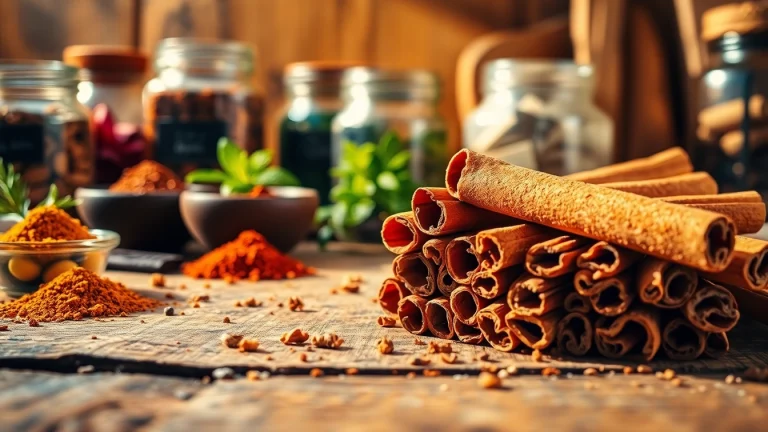
Cinnamon Bark: The Versatile Spice for Flavor and Health Benefits
Cinnamon bark is not just a delightful addition to your culinary repertoire; it’s a spice steeped in history and packed with benefits that have made it a cherished ingredient around the globe. From its ancient origins to modern uses, the allure of this spice is undeniable. To explore its fascinating journey, let’s delve into the various aspects of cinnamon bark, including its history, health benefits, culinary applications, and more. For the highest quality cinnamon bark, check out this Cinnamon Bark.
Understanding Cinnamon Bark: Its Origins and Types
History and Cultural Significance of Cinnamon Bark
Cinnamon has been a prized spice for thousands of years, with historical records dating back to ancient Egypt, where it was sought after for its aromatic properties and medicinal applications. The spice was so highly valued that it was considered more precious than gold at times. Historically, cinnamon was used in religious ceremonies, as incense, and as a symbol of wealth and luxury. The spice played a crucial role in trade routes, particularly during the Middle Ages, where it was transported from Sri Lanka (formerly Ceylon) and other regions to Europe.
Types of Cinnamon Bark: Ceylon vs. Cassia
There are primarily two main types of cinnamon: Ceylon cinnamon and Cassia cinnamon (often referred to simply as “cinnamon”). Ceylon cinnamon, known as “true cinnamon,” is characterized by its delicately sweet flavor and lighter color. It is native to Sri Lanka and is often considered to be of higher quality. Cassia cinnamon, on the other hand, is more commonly found in supermarkets and is stronger in flavor, with a spicier note. It typically contains higher levels of coumarin, which can be harmful in excessive amounts. Understanding the differences in flavor profiles and health implications can help consumers make informed choices when selecting cinnamon for their diets.
Flavor Profile and Aroma of Cinnamon Bark
The flavor of cinnamon bark varies significantly between the two types. Ceylon cinnamon has a delicate, sweet, and citrusy flavor, making it ideal for desserts and sweet dishes. Cassia, with its bold, pungent, and slightly bitter notes, stands up well in savory concoctions, spiced teas, and hearty winter dishes. The aroma of both types is warm and inviting, conjuring images of cozy kitchens and holiday gatherings. Understanding these nuances allows for more creative culinary expression.
Health Benefits of Cinnamon Bark
Antioxidant Properties of Cinnamon Bark
Cinnamon bark is renowned for its high antioxidant content, particularly polyphenols, which help to combat oxidative stress in the body. This is critical as oxidative stress is linked to numerous health issues, including heart disease and aging. Regular consumption of cinnamon can increase the antioxidant levels in the blood, offering protective effects against free radicals. Incorporating cinnamon into one’s diet can be a delicious way to optimize health and bolster the immune system.
Cinnamon Bark for Blood Sugar Regulation
Numerous studies have shown that cinnamon can help regulate blood sugar levels, making it particularly beneficial for individuals with Type 2 diabetes. Cinnamon may improve insulin sensitivity and lower fasting blood sugar levels, making it a useful dietary addition for those managing diabetes. An effective and practical way to incorporate cinnamon is to sprinkle it on daily breakfast items like oatmeal or smoothies. Research suggests that even small amounts can significantly contribute to improved glycemic control.
Anti-inflammatory Effects of Cinnamon Bark
Chronic inflammation is often the root cause of many diseases, including arthritis and cardiovascular issues. Cinnamon bark contains several compounds that possess anti-inflammatory properties. Regular intake of cinnamon may help reduce inflammation in the body, relieving symptoms associated with chronic inflammatory conditions. This can be particularly beneficial for individuals with inflammatory diseases, offering a natural and tasty method to alleviate their symptoms.
How to Use Cinnamon Bark in Cooking
Incorporating Cinnamon Bark in Sweet Dishes
Cinnamon is a staple in countless sweet recipes. It enhances the flavors of baked goods like cinnamon rolls, apple pies, and even cookies. One way to incorporate cinnamon bark into your sweet dishes is by steeping it in hot liquids, such as milk or cream, to impart its flavor before using it in whips or frostings. Additionally, try adding a sprinkle to breakfast items like pancakes, muffins, or granola for an extra touch of warmth and sweetness.
Savory Recipes Featuring Cinnamon Bark
Beyond sweetness, cinnamon bark can profoundly enrich savory dishes. In Middle Eastern cuisines, it’s often added to stews, tagines, and spice blends, bringing depth and intricate layers of flavor. A classic Moroccan tagine, laden with vegetables, meats, and a hint of cinnamon can elevate a simple meal to an extraordinary culinary experience. Experimenting with cinnamon in rice dishes, chili, or even curries can yield delightful surprises.
Cinnamon Bark in Beverages
Cinnamon bark is a popular ingredient in various beverages, adding warmth and depth. Think about classic drinks like chai tea, where it plays an essential role. Infusing hot beverages, such as teas or coffees, with cinnamon can create an aromatic and health-boosting drink. Even smoothies can benefit from a pinch of cinnamon, enhancing the flavor profile while also contributing to the nutritional value.
Choosing and Storing Cinnamon Bark
How to Select Quality Cinnamon Bark
Selecting high-quality cinnamon bark is crucial for both flavor and health benefits. When shopping, look for Ceylon cinnamon if possible, as it offers a more delicate flavor and lower coumarin levels. Quality cinnamon should have a rich aroma and be free from any signs of mold or excessive moisture. Whole sticks of cinnamon are generally preferable to ground varieties, as they maintain their flavor longer and give you more control over the amount used.
Proper Storage Techniques for Cinnamon Bark
To preserve the freshness and potency of cinnamon bark, proper storage is key. Store whole cinnamon sticks in an airtight container in a cool, dark place, away from heat and light, which can degrade the essential oils that contain its flavor. Ground cinnamon, however, should be used more quickly due to its tendency to lose potency faster than whole sticks. Keeping it stored in a covered container in a pantry will help to prolong its shelf life.
Signs of Freshness in Cinnamon Bark
Fresh cinnamon bark should have a highly aromatic and sweet scent. If the fragrance is faint or musty, it may be past its prime. Visually, fresh sticks will have an even, rich color, and when broken, they should be dry yet not brittle. There should be no signs of mold or changes in texture. Regularly checking your spice stash will ensure you’re using the best quality cinnamon in your culinary endeavors.
Exploring the Global Use of Cinnamon Bark
Cinnamon Bark in Different Cuisines
Cinnamon is a global spice that finds its way into a variety of cuisines. In Indian cooking, garam masala often contains cinnamon, which adds warmth to curries and flatbreads. In North African cuisines, cinnamon is frequently used in both savory and sweet dishes alike. The versatility of this spice extends to Asian cooking as well, where it can be found in several traditional dishes, providing layers of flavor that are comforting and exotic at the same time. Each culture uses cinnamon in unique and traditional ways that showcase its adaptability.
Medicinal Uses of Cinnamon Bark Around the World
Cinnamon bark has been utilized in traditional medicine for centuries. In Ayurveda and Traditional Chinese Medicine, it is used to treat a variety of ailments, ranging from cold symptoms to digestive issues. Its potent antibacterial and antifungal properties have made it a staple in natural remedies. The use of cinnamon in folk medicine illustrates its importance not just as a culinary spice but also as a holistic healing agent worldwide.
The Future of Cinnamon Bark in Culinary Trends
As consumers increasingly seek out natural and sustainable foods, the future of cinnamon bark looks promising. With growing interest in plant-based diets and holistic health, cinnamon is likely to remain a fashionable ingredient among chefs and home cooks alike. Its versatility allows for innovative applications across the food industry, from gourmet desserts to health-focused products. Moreover, as research continues to unveil the extensive health benefits of cinnamon, its popularity is poised to rise.


